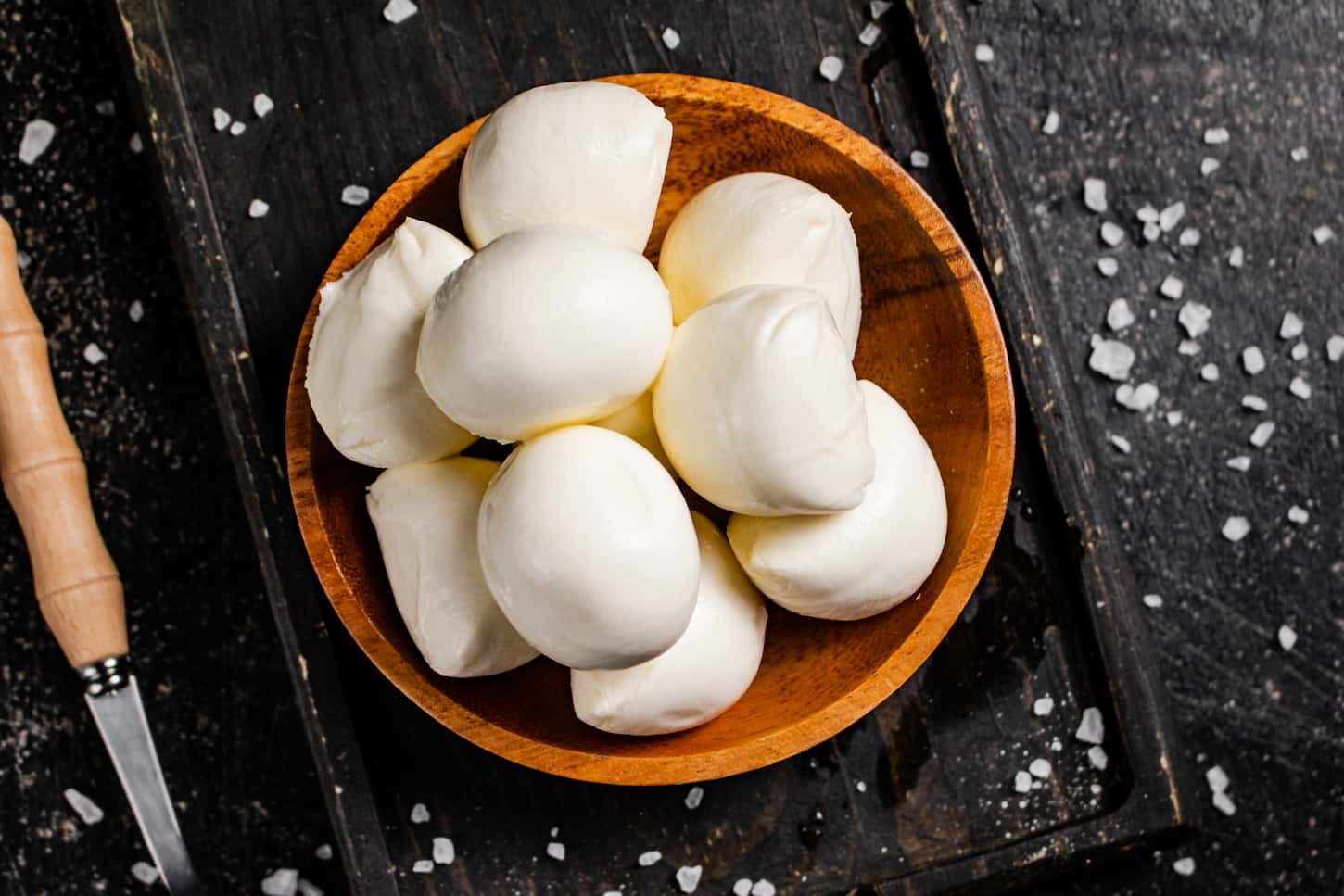If you produce milk and dairy products on your homestead, the last thing you want to do is waste them. But storing dairy products such as cheese long-term isn’t easy. Cheese only lasts for around 6 months in a freezer. So, you might be wondering if freeze-drying cheese might be an option?
Cheese freeze-dries well if it’s in small pieces, shredded, cubed, or sliced. Freeze-dried and stored properly, cheese can last up to 20 years. Freeze-dried cheese can also be powdered for easier use in the future.
If you want to store cheese long-term, then freeze-drying is the only viable option. So, we’re going to tell you everything you need to know about freeze-drying cheese in the helpful guide.

What’s Freeze-Dried Cheese?
Freeze-dried cheese is the cheese that has been passed through a freeze-drying machine. It’s usually shredded (or cubed) and lightweight because all the moisture has been removed. Unlike standard freezing, freeze-dried cheese will retain the same taste and texture as fresh cheese once it’s been rehydrated.
With standard freezing, the water in our food slowly turns into ice. This stops bacteria from growing and slows down the decomposition process. However, the ice in frozen food will expand and ultimately damage the cell walls of the food. And therefore, frozen food is often mushy when you thaw it out, especially cheese.
Freeze dryers work in a different way than normal freezers. Freeze-dryers not only freeze the food, but they remove the moisture, too. And when there’s no moisture in the food it won’t spoil or decompose, unlike standard freezing which just slows down the decomposition process.
Freeze-drying slows down the decomposition process, too, but it takes much longer. Usually, it takes decades instead of months.
Another good thing about freeze dryers is that they don’t damage the structure of the food. A freeze dryer will rapidly freeze the food, so the ice doesn’t get a chance to expand. This means that once you’ve rehydrated it, freeze-dried cheese will be pretty much the same texture and consistency as fresh cheese.
If you’d like to know more about how freeze-dryers work, make sure you check out our article here on the science behind how freeze-dryers work.
How to Freeze Dry Cheese
Cheese can be freeze-dried normally, though it must be in small pieces to freeze-dry well. Cheese does best when shredded, cut into small chunks, or thinly sliced first. Cheese also benefits from a pre-freeze in the freezer before being freeze-dried.
Not only is this more practical when it comes to using the cheese but it’s also better for the freeze-drying process.
If you want to freeze dry soft cheeses, there are two ways to do that.
- First, you can spread these out evenly on the freeze-drying tray. You may want to use a silicone mat or a piece of baking parchment, though. Afterward, you simply break chunks of it out of the tray for storage.
- Or you can freeze-dry soft cheese in small, convenient portions in silicone ice cube trays.
It takes a freeze dryer around 20 hours to complete a cycle when freeze-drying cheese. However, you can reduce the freeze-drying time of your cheese by pre-freezing it in your standard freezer.
- Pro-tip #1: end your freeze-dryer cycle on a hot or warm cycle. That way, food taken out won’t be at risk of condensation when being taken out of the freezing into room-temperature air.
- Pro-tip #2: Put freeze-dried foods into a Ziplock baggie and store it for up to a few days. This way, you can test for moisture before putting the food into a Mylar bag for permanent storage. This trick has helped us so many times!
These tips are important ways to minimize the amount of moisture and air your food is exposed to, while also giving you a window to make sure that they’re properly freeze-dried.
We’ve had a few times when our post-freeze-drying Ziplock test has shown us (usually within just a few hours) that the food wasn’t as moisture-free as we’d thought it was. Thankfully, it’s still salvageable at that point. Just pop it back in the freeze-dryer for another few rounds – and test it again when the cycle ends on another warm spell.

How to Reconstitute Freeze-Dried Cheese
Cheese reconstitutes from being freeze-dried best when done slowly. If cheese is reconstituted too quickly, it might stay crunchy inside or change how it melts. Reconstituting freeze-dried cheese slowly back to its original form takes at least 4-6 hours.
To reconstitute cheese slowly, you need to put it into a glass bowl. Then you need to add small amounts of water to it while you stir it with a spoon. When water starts to gather at the bottom of the bowl, this means that you’ve added enough. The cheese should be wet but not mushy or soggy.
Next, you need to drain away any excess water and transfer your cheese into an airtight container or a Ziplock bag. Then you need to put it in the refrigerator and let it sit for a few hours.
Alternatively, you can put the cheese straight into a Ziplock bag with a wet towel and put it in the fridge. The cheese will slowly absorb the amount of water it needs from the towel. This will give the cheese a perfect consistency.
Rapid Reconstitution
If you want to reconstitute cheese quickly, you can use slightly warm water to reconstitute it. However, make sure the water isn’t too hot or it will melt the cheese. You can also lay the cheese out on some towels and spray it with a fine mist of water. This will make the outside of the cheese soft, but keep in mind that might still be a bit crunchy in the middle.
You don’t have to reconstitute cheese before you eat it. It also makes a tasty snack in its dried state. And it’s worth noting that reconstituted cheese only lasts for around a week in the fridge, so it’s better if you only reconstitute the amount you need.
How to Store Freeze Dried Cheese
Store freeze-dried food in sealed containers away from air and moisture. The best way to store freeze-dried food is in Mylar bags with oxygen absorbers. The way cheese is stored after being freeze-dried is important. Improperly stored cheese will spoil while in the storage bag.
The most important thing when it comes to storing your cheese is that it must be completely dry first. If it’s not completely dry, it’ll spoil. The best way to check to see if your cheese is dry is by taking a bite out of a piece. If it feels all dry, then it’s usually good to go. But if you feel any moisture or cold with your tongue, it needs a bit longer in the freeze dryer.
Once the cheese is completely dry, you can transfer it into Mylar bags. These are perfect for storing freeze-dried food because they’re easy to use, inexpensive, and completely airtight. As well as this, they come with oxygen absorbers to absorb any rogue bits of air out of the bag.
If you have canning equipment, you can also store your freeze-dried cheese #10 cans. Other options include vacuum bags or pantry jars. However, the cheese won’t last as long in these containers because they’ll let in trace amounts of oxygen over time.
Once you’ve opened up a packet or can of freeze-dried cheese, it can last for up to a year. Just make sure that you keep the container sealed in between usage. And keep it stored in a cool, dry place.
How to Powder Freeze-Dried Cheese
Freeze-dried cheese can be powdered easily in one of several methods.
- Pass the freeze-dried cheese chunks through a food processor or coffee grinder.
- Put the freeze-dried cheese in a Ziplock baggie and powder the cheese with a rolling pin.
Cheese powder is an incredibly versatile and tasty ingredient. So, the great news is that it’s easy to make cheese powder from your freeze-dried cheese.
Powdered cheese can bring a burst of concentrated flavor to many dishes. And you can add it directly to dishes without having to rehydrate it. You can use it to make soups, sauces, or dips. And you can sprinkle it on as a seasoning for most foods.
As well as this, the texture of cheese powder is much better for sauces. This is because it blends in easily and isn’t stringy like some freeze-dried shredded cheeses.
When you buy cheese powder, often, this isn’t freeze-dried cheese. Instead, it’s been produced using a method called spray drying. With spray drying, the cheese is highly processed and turned into cheese slurry.
This slurry often contains all kinds of additives such as phosphates, citric acid, whey, corn syrup, and vegetable oils. So overall, homemade cheese powder is much better for your health because it’s made from 100 percent cheese with no extras or additives. Unless you put them there, and then that’s your call.
Does Freeze Dried Cheese Melt Easily?
Freeze-dried cheese will melt easily unless it’s still dry anywhere. To get a lovely melting cheese topping, the cheese must be reconstituted back to its normal consistency with water first.
- If you want melted cheese on a pizza, for example, it’s better to use properly reconstituted cheese. Dry cheese will just turn brown and crispy on your pizza.
- But for a casserole topping, so long as you cover it with foil, you can reconstitute and melt the cheese at the same time. This is because the cheese will absorb moisture from the casserole.
If you want instant melted cheese, you can put some freeze-dried cheese in the microwave with some water. Heat it gradually and stir it regularly until you have a bowl of gooey melted cheese that you can drape on top of sandwiches or baked dishes.
Tip: if you’re only ever going to melt the cheese you’ve got freeze-dried, consider powdering it. Powdered cheese will reconstitute more quickly, letting you get back to baking (and melting cheese) that much faster.

Can You Freeze Dry All Kinds of Cheese?
All cheeses (hard and soft) can be freeze-dried, though their storage times can vary depending on the cheese. Cheddar, mozzarella, and Monterrey Jack all freeze-dry well, but so do blue cheese, feta, and soft cheeses.
This means that with a freeze dryer, you can have a whole selection of cheeses in your food store. You can turn them into powders to create unique and delicious cheese sauces. As well as this, dried feta chunks are great in a salad. Or you can add cottage cheese powder to your muesli for extra protein.
What Other Dairy Products Can I Freeze Dry?
Freeze-dryers can preserve most dairy products, including cream, yogurts, eggs, kefir, and even ice cream products. Dairy products may not keep a full 25-30 years or more when freeze-dried, but some can be safely stored for 15 years or more.
So, let’s take a look at what dairy products you can put in the freeze dryer.
- Milk – You can freeze dry all types of milk, though full-fat milk will have a shorter storage life.
- Eggs – You can freeze-dry eggs in any state, scrambled, boiled, or raw. But you must remove them from their shells before freeze-drying.
- Cream – It’s easy to freeze dry cream. But it’s better to water heavy, thick cream down before you put it in the freeze-dryer.
- Yogurt and Kefir – Both are good in the freeze dryer. Freeze dry them in small portions to make a tasty instant snack.
- Ice cream treats – Just be sure to cut any ice cream treats into small pieces and pre-freeze before freeze-drying (or you get a freeze-dried puddle).
Our family loves freeze-drying yogurt. Grocery stores sell freeze-dried yogurt melts, but they’re expensive. So, we make our own, and it’s a favorite treat for us all.
We also love freeze-drying 1-inch bites of Fat Boy ice cream sandwiches. They’re delicious – no reconstitution needed. It’s a great way to have a treat that makes you feel cool when you’re out camping. Just don’t forget to drink some extra water!
Can I Freeze Dry Butter?
Foods that are high in fat and sugar, like butter, don’t freeze-dry as well on their own, but they freeze-dry well enough as an ingredient in a dish.
It may be better to store these in the freezer. But don’t worry about freeze-drying things that have butter or chocolate as ingredients. It’s usually ok to freeze-dry them as ingredients in other things.
That can include casseroles, though make sure you read my article on freeze-drying casseroles for more tips and advice.
Can I Freeze Dry Chocolate?
Chocolate, being high in fats and sugar, doesn’t freeze-dry as well on its own, but it can freeze-dry as an ingredient in a dish.
Remember our rule of thumb from butter: the less you’re able to see the chocolate, then the better the dish will freeze-dry. For example, chocolate chip cookies won’t freeze-dry as well as chocolate cookies, due to the larger chunks of chocolate.
But why are we freeze-drying cookies instead of eating them?
Freeze Dried Cheese Tips
Once you’ve reconstituted it, you can use freeze-dried cheese in the same way that you would fresh cheese. And for some ideas about how to use freeze-dried cheese, look at our tips below.
Freeze Dried Mozzarella
Freeze-dried mozzarella is a must for any Italian dish such as pasta and pizza. But you can use freeze-dried mozzarella for a whole range of other things too.
- Shredded Mozzarella – This is fantastic for quiches, or you can use it to make stringy Mexican quesadillas.
- Mozzarella Powder – Turn your freeze-dried mozzarella into powder and mix it with cheddar powder to create the ultimate mac and cheese sauce.
- Sliced Mozzarella – Sliced mozzarella is perfect for layering a lasagna or melting in paninis.
- Mozzarella Chunks – Use chunks to fill tacos or tortilla wraps or toss them in a healthy salad.
Freeze Dried Cheddar
Cheddar is by far one of the most versatile cheeses, even more so when it’s been freeze-dried. And here are some things you can do with freeze-dried cheddar cheese.
- Shredded Cheddar – Use a combination of shredded cheddar and mozzarella for the ultimate grilled cheese.
- Cheddar Powder – Cheddar powder is incredibly versatile. You can add it to soups, sauces, casseroles, and dough. As well as this, you can use it as a seasoning for potato wedges, French fries, and even popcorn.
- Sliced Cheddar – Layer slices of freeze-dried cheddar between hamburger patties for the ultimate cheeseburger.
- Cheddar Chunks – Freeze-dried cheddar chunks make a tasty and convenient snack without being reconstituted. You can put them in lunch boxes or take them with you on a hike or a picnic.

Conclusion: Freeze-dried Cheese
Not only is cheese a tasty family favorite, but it’s also a good source of fat and protein. So, it’s a great item to have in your food storage. And when it comes to storing cheese long-term, freeze-drying is the best option. Once it’s been freeze-dried, if you store it correctly, cheese can last for up to 20 years.
So, get out there and enjoy some freeze-dried cheese. Or, if you’d rather try before you buy a freeze-dryer and make your own, that’s totally fine. Here are some great options to try via Amazon.
- Click here to shop for Augason Farms cheese blend powder on Amazon.
- Shop for shredded Nutristore freeze-dried mozzarella by clicking here.
- Or click here to see all freeze-dried cheese options on Amazon.
Or go shop for your own freeze-dryer at Harvest Right now. If the sample food pack is available, be sure to grab that, too!
Or, if you’d rather get back to freeze-drying your cheese (or whatever else), make sure you read this article about freeze-drying next. It’ll surprise you how much easier it is than you thought!
Resources
Learning from your own experience is essential, but learning from others is also intelligent. These are the sources used in this article and our research to be more informed as homesteaders.
- Hoaks, Donna. “Cheese Lovers, Unite!” Harvest Right | Home Freeze Dryers | Freeze Dried Food Storage, 15 Nov. 2019, harvestright.com/blog/2019/cheese-lovers-unite.
- Howard, Robin. “Rehydrating Freeze Dried Dairy.” Harvest Right | Home Freeze Dryers | Freeze Dried Food Storage, 15 Nov. 2019, harvestright.com/blog/2016/rehydrating-freeze-dried-dairy.
- Loucks, Jessilee. “Powdered Cheese Method and Product.” Patents, 5 Dec. 2016, patents.google.com/patent/WO2018106728A1/en.
